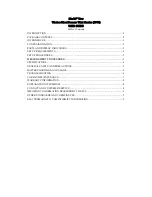
8
5.2. Common sources of error:
Note:
Comparable blood pressure measurements always require the same conditions!
These are normally quiet conditions.
• Efforts by the patient to support the arm can increase blood pressure. Make sure you are in a
comfortable, relaxed position and do not activate any of the muscles in the measurement arm during
the measurement. Use a cushion for support and rest your arm on a table.
• If the upper arm artery lies considerably lower or higher than the heart, a false high or low blood
pressure will be measured!
*A variation of 6” between the cuff and heart level can result in a reading error of + or -
10mmHg.
• Cuffs that do not fit properly result in false measurement values. Selecting the correct cuff is extremely
important. The cuff size is dependent upon the circumference or distance around your upper arm
measured in the center. The permissible range is printed on the cuff. If this is not suitable for your use,
please contact Microlife.
Note:
Only use clinically approved
Microlife Cuffs.
• A loose cuff or a sideways protruding air-pocket causes false measurement values.
• Measurements should be done after a 5 minute rest to ensure accuracy.
• Consecutive blood pressure measurements should be performed after a 1 minute pause.
5.3. Fitting the cuff
a) Pass the end of the cuff through the flat metal ring so that a loop
is formed. The Velcro closer must be facing outwards. (Ignore
this step if the cuff has already been prepared.)
b) Place the cuff over the left upper arm so that the tube is closer to
your lower arm. Align the cuff artery mark (arrow) over the arm
artery than runs down the inner side of the arm.
c) Lay the cuff on the arm as illustrated. Make certain that the
lower edge of the cuff lies approximately 3/4” to 1” (2 to 3 cm)
above the elbow and that the tube is closer to the inner side of
the arm.
2–3 cm
tube
Содержание BP 3AQ1
Страница 1: ...MLU3AQ1 APR09 1...











































